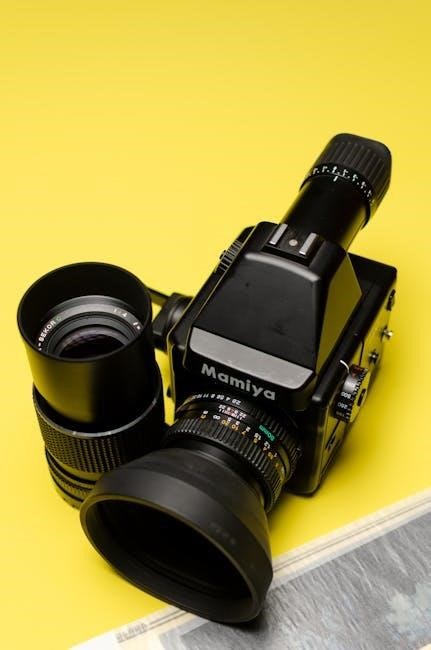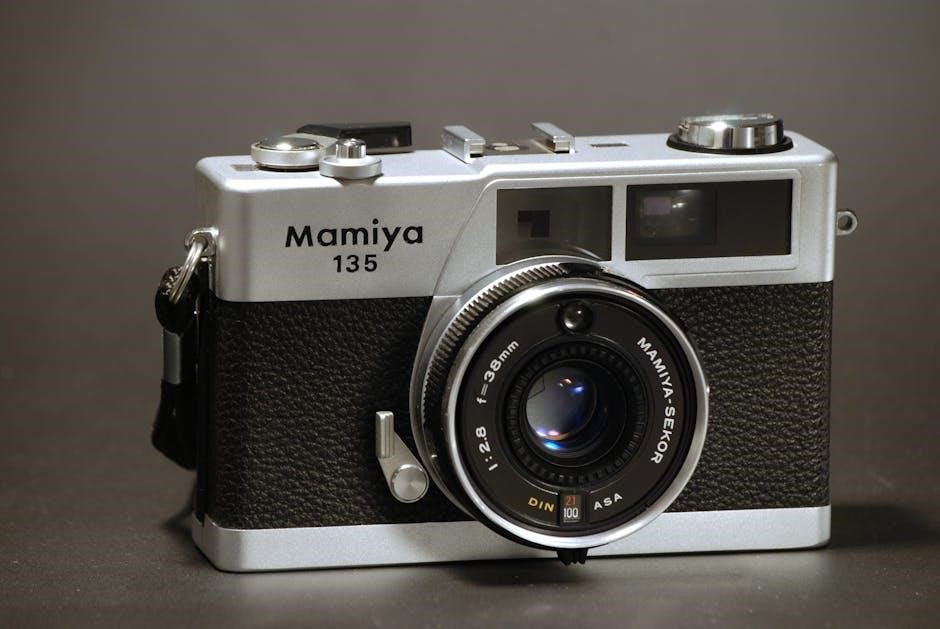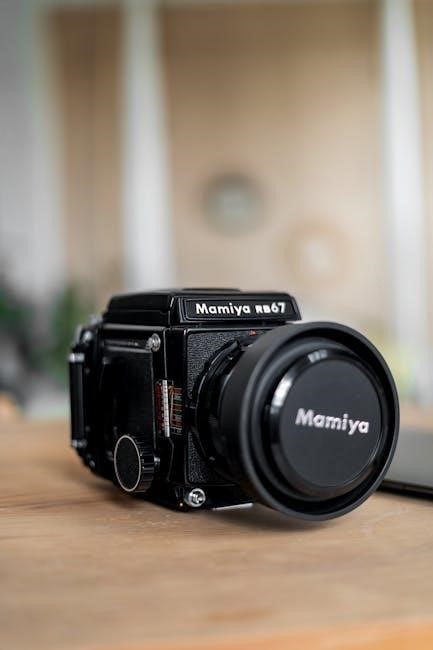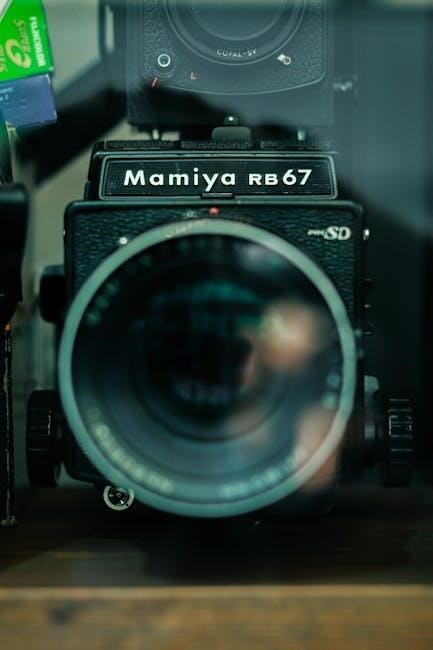The Mamiya M645 is a 6×4.5cm medium format SLR camera beloved by professionals and enthusiasts alike for its robust design, durability, and modular system. Known for its exceptional image quality and versatility, the M645 has become a workhorse in the world of photography, offering unparalleled control over creative processes. Its enduring popularity underscores its significance in the realm of medium format photography.
Overview of the Mamiya M645 Camera
The Mamiya M645 is a 6×4.5cm medium format SLR camera designed for professional photographers and enthusiasts. Known for its durability and versatility, it features a modular design, allowing users to customize their shooting experience. The camera supports interchangeable lenses, offering flexibility for various photography genres. Its robust build and intuitive controls make it a reliable choice for both field and studio work; With its reputation for producing high-quality images, the Mamiya M645 has become a favorite among photographers seeking precision and creativity. Understanding its operation through the manual is essential to unlock its full potential.
Importance of the Mamiya M645 Manual
The Mamiya M645 manual is an essential resource for photographers seeking to master this medium format camera. It provides detailed instructions on camera operation, lens compatibility, and advanced shooting techniques. By understanding the manual, users can optimize the camera’s features, troubleshoot common issues, and maintain its performance. The manual also serves as a guide for customizing the camera with accessories, ensuring photographers can adapt it to their unique needs. Whether for professional or enthusiasts, the manual unlocks the full potential of the Mamiya M645, making it indispensable for achieving high-quality results and extending the camera’s longevity.

Key Features of the Mamiya M645
The Mamiya M645 is a 6×4.5cm medium format SLR camera, known for its modular design, interchangeable lenses, and its durability, favored by professionals and enthusiasts.
6×4.5cm Medium Format Film Camera
The Mamiya M645 is renowned for its 6×4.5cm medium format film capability, offering exceptional image quality with a 1.5x larger negative size than 35mm film. This format allows for greater detail and tonal range, making it ideal for professional photography. The manual highlights the camera’s ability to leverage the 6×4.5cm format for high-resolution images, ensuring sharpness and clarity. Photographers appreciate the aspect ratio, which provides a balanced composition in both portrait and landscape orientations. The manual also guides users on optimizing the camera’s film handling and advancing mechanisms for seamless shooting experiences.
The 6×4.5cm format is a cornerstone of the M645’s design, enabling photographers to achieve professional-grade results with ease. The manual emphasizes proper film loading and unloading techniques to prevent damage and ensure consistent performance. By mastering the 6×4.5cm format, users can fully exploit the camera’s potential, delivering outstanding photographs in various genres, from studio to landscape photography.
Interchangeable Lenses and Lens Compatibility
The Mamiya M645 features a versatile interchangeable lens system, allowing photographers to choose from a wide range of high-quality Mamiya-Sekor lenses, including wide-angle, telephoto, and macro options. According to the manual, the camera supports lenses with the Mamiya 645 mount, ensuring compatibility across the entire M645 series. Adapters are also available for third-party lenses from systems like Contax, Hasselblad, and Pentacon SIX, expanding creative possibilities. The manual provides detailed guidance on lens installation, compatibility, and optimization, enabling users to maximize their camera’s potential for diverse photography applications, from portrait to landscape and studio work.
Modular Design and Accessories
The Mamiya M645 boasts a highly modular design, offering extensive customization to suit various photography needs. According to the manual, the camera supports interchangeable viewfinders, such as the prism finder and waist-level finder, allowing photographers to choose their preferred viewing style. Accessories like grips, cases, and adapters expand functionality, with compatibility for systems like Contax and Hasselblad. The manual details how to integrate these components seamlessly, ensuring optimal performance. This modular approach enhances versatility, making the M645 adaptable for studio, portrait, and field photography applications while maintaining its renowned durability and reliability.

Understanding the Mamiya M645 Manual
The manual provides a detailed guide to the camera’s features, controls, and operation, ensuring users can maximize its potential. It covers setup, shooting modes, and maintenance, offering clear instructions for optimal performance and troubleshooting common issues, making it an essential resource for both beginners and experienced photographers.
Structure and Content of the Manual
The Mamiya M645 manual is organized into clear sections, starting with an introduction to the camera’s features and operation. It details camera controls, shooting modes, and maintenance procedures, ensuring users understand each function. The manual includes troubleshooting guides, repair tips, and compatibility information for lenses and accessories. Detailed diagrams and charts are provided to aid comprehension. Appendices cover technical specifications and warranty details, making it a comprehensive resource for photographers. The structure is logical, allowing users to easily navigate and find specific information, ensuring they can fully utilize the camera’s capabilities and maintain it effectively over time.
Reading and Interpreting the Manual
Reading the Mamiya M645 manual requires attention to detail to fully grasp its features and operation. Start by familiarizing yourself with the table of contents to navigate sections efficiently. Pay close attention to diagrams and charts, as they provide visual guidance for complex procedures. Symbols and abbreviations are explained within the manual, ensuring clarity. Troubleshooting sections offer solutions to common issues, while maintenance tips help extend the camera’s lifespan. By thoroughly understanding the manual, users can unlock the camera’s full potential, ensuring optimal performance and creative control in their photography.
Operating the Mamiya M645
Understanding and operating the Mamiya M645 requires mastering its modular design, manual focus, and interchangeable lenses. The manual provides clear guidance on setup, ensuring precise control over exposures and creative outcomes.
Basic Camera Controls and Functions
The Mamiya M645 features intuitive controls designed for precise photography. The mode dial allows switching between manual and aperture-priority modes, while the aperture and shutter controls provide tactile adjustments. The film advance lever ensures smooth loading, and the viewfinder offers a clear preview of compositions. The manual focus mechanism, supported by interchangeable lenses like the Mamiya-Sekor 80mm f/2.8, enables sharp imagery. Understanding these controls is essential for mastering the camera’s capabilities, as detailed in the manual, which guides users through setup and operation for optimal results in various shooting scenarios.
Setting Up the Camera for Shooting
Setting up the Mamiya M645 involves several key steps to ensure optimal performance. Begin by attaching the prism finder or waist-level viewfinder, depending on your preference. Next, load the 120 or 220 film, ensuring it is properly seated on the spool. Set the film speed using the ISO dial, matching the film’s sensitivity. Choose the desired mode—manual or aperture priority—and select the appropriate aperture and shutter speed. Finally, focus using the lens’s manual focus ring and frame your shot. Proper setup, as outlined in the manual, ensures precise control and exceptional image quality in various lighting conditions.
Advanced Shooting Modes and Techniques
The Mamiya M645 offers manual mode for full exposure control and aperture priority for creative flexibility. It allows precise adjustment of depth of field and lighting, guided by the manual.
Manual Mode and Exposure Control
The Mamiya M645 offers precise manual control over exposure settings, allowing photographers to fine-tune aperture, shutter speed, and film sensitivity. The camera’s manual mode enables full creative control, with adjustments made via intuitive dials and levers. The exposure compensation dial provides +/-2 stops of adjustment, ensuring optimal results in varying lighting conditions. Photographers can also use the built-in light meter for accurate readings, though external meters may be preferred for critical work. The Mamiya-Sekor lenses further enhance manual focusing and aperture control, making the M645 a versatile tool for professional and artistic photography. Always refer to the manual for proper handling to avoid errors.
Aperture Priority and Other Shooting Modes
The Mamiya M645 supports aperture priority mode, allowing photographers to set the desired aperture while the camera automatically adjusts the shutter speed. This mode is ideal for controlling depth of field while maintaining proper exposure. Additionally, the camera offers manual mode for full creative control and other shooting modes tailored for specific scenarios. The M645’s modular design and interchangeable lenses further enhance its versatility, enabling photographers to adapt to various shooting conditions. By leveraging these modes, users can achieve precise and artistic results, making the M645 a trusted choice for both professionals and enthusiasts in medium format photography.

Maintenance and Care
Regular maintenance ensures the Mamiya M645’s longevity. Clean the camera body and lenses with soft cloths, service regularly, and store in a dry, cool place.
Cleaning and Servicing the Camera
Regular cleaning and servicing are essential to maintain the Mamiya M645’s performance. Use a soft, dry cloth to wipe the camera body and lenses, avoiding harsh chemicals. For the mirror and viewfinder, gently remove dust with a microfiber cloth. Inspect for signs of wear or damage, such as short circuits in the prism finder circuit. Professional servicing is recommended for complex repairs. Always handle the camera with care to prevent mechanical stress. Store the camera in a cool, dry place to protect it from humidity. Refer to the manual for detailed instructions on maintenance and repair procedures.
Storage and Handling Tips
Proper storage and handling are crucial to preserve the Mamiya M645’s functionality and longevity. Store the camera in a protective case with silica gel packets to absorb moisture and prevent humidity damage. Keep it in a cool, dry place away from direct sunlight and chemicals. Avoid stacking heavy objects on the camera or lenses to prevent mechanical stress. Always handle the camera with clean, dry hands to minimize fingerprints and smudges. When not in use, detach lenses and store them separately in protective caps. Regularly inspect for signs of wear or corrosion, and address issues promptly to maintain optimal performance. Follow the manual’s guidelines for safe handling and storage practices.

Troubleshooting Common Issues

The Mamiya M645 may experience issues like jammed film, inaccurate metering, or faulty shutters. Refer to the manual for diagnostic steps and solutions to ensure optimal functionality.
Common Problems and Solutions
Common issues with the Mamiya M645 include film jamming, inaccurate metering, and faulty shutter mechanisms. For film jams, ensure proper film alignment and gentle advancing. Metering inaccuracies may require calibration or cleaning of light-sensitive cells. Faulty shutters can often be resolved by cleaning or replacing worn parts. Lens compatibility issues can arise; always verify compatibility before use. Electrical malfunctions may indicate a need for circuit repair, such as the prism finder circuit. Refer to the manual for disassembly and repair guides. Regular maintenance and proper handling can prevent many of these issues, ensuring optimal camera performance and longevity.
Repair and Service Options
For repairs, the Mamiya M645 can be serviced by authorized centers or skilled technicians specializing in medium format cameras. Refer to the official service manual for disassembly and repair procedures. Common repairs include replacing worn shutter parts, cleaning or replacing light meters, and fixing electrical circuits, such as the prism finder circuit. Self-service is possible for minor issues, but complex repairs require professional expertise. Additional resources, like PDF manuals and online forums, provide guidance for DIY fixes. Ensure all repairs are done carefully to maintain the camera’s functionality and longevity, as improper handling can lead to further damage.
The Mamiya M645 remains a legendary camera in medium format photography, celebrated for its durability and versatility. Its manual serves as an essential guide, ensuring optimal use and longevity.
The Legacy of the Mamiya M645
The Mamiya M645 has left an indelible mark on medium format photography, renowned for its robust build, reliability, and adaptability. Introduced in the 1970s, it became a favorite among professionals and enthusiasts, offering a perfect balance of functionality and portability. Its modular design and interchangeable lenses allowed photographers to tailor the camera to their needs, making it versatile for various genres. The M645’s enduring popularity is a testament to its craftsmanship and the creative freedom it provides. With a dedicated community and extensive resources, including manuals and accessories, the M645 continues to inspire photographers, ensuring its legacy endures in the world of film photography.
Final Tips for Using the Manual Effectively
To maximize your use of the Mamiya M645 manual, start by thoroughly reading and understanding its structure. Pay attention to diagrams and explanations of camera controls. Practice adjusting settings like aperture, shutter speed, and ISO as described. Refer to the troubleshooting section for common issues and solutions. Keep the manual handy during shoots for quick reference. Experiment with advanced techniques, such as manual mode, to refine your skills. Regularly review the manual to discover new features and optimize your workflow. By mastering the manual, you’ll unlock the full potential of your Mamiya M645 and enhance your photographic creativity.
